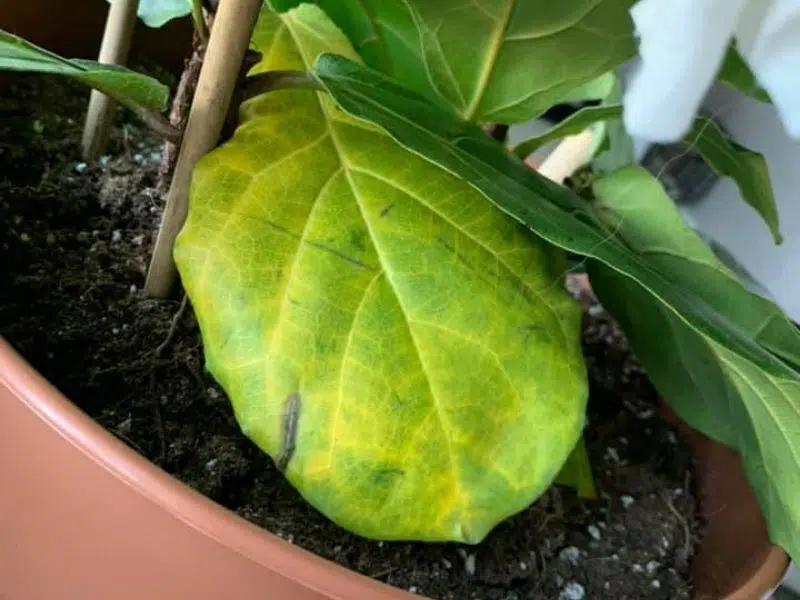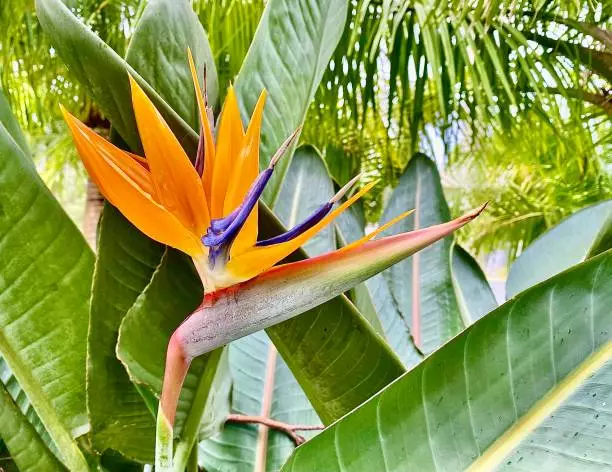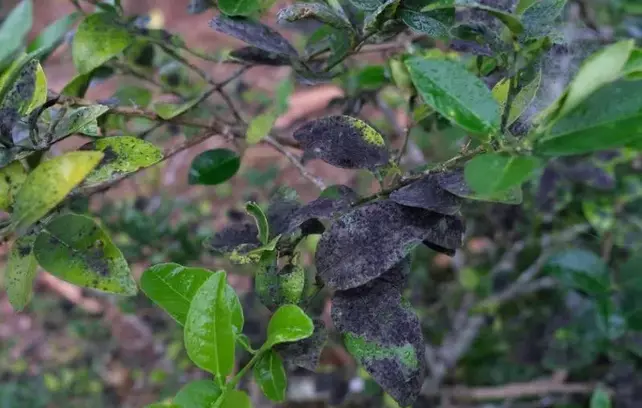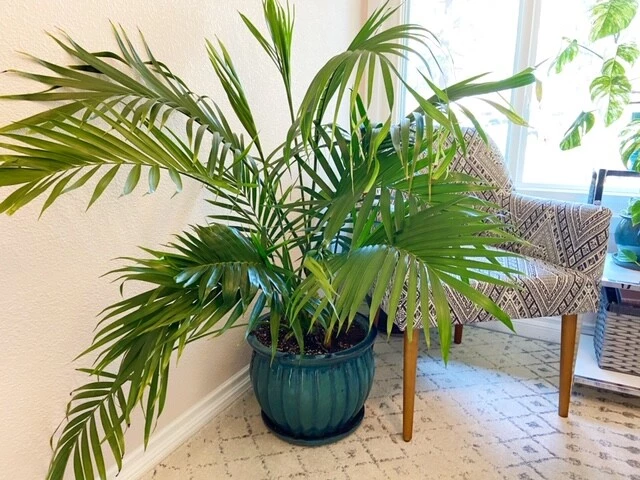Peace lilies (Spathiphyllum) produce white flowers that make them very attractive indoor plants especially when they bloom repeatedly. With proper care, these plants naturally bloom in spring. In some cases, you’ll have a peace lily that’s not flowering. How do you make it bloom again?
To get a peace lily to flower, provide bright indirect sunlight by placing the plant near a window while keeping its soil moist all the time. Feed the peace lily with a balanced fertilizer and keep the environment around it warm (68-85 °F) to stimulate blooming.
Why your peace lily is not flowering
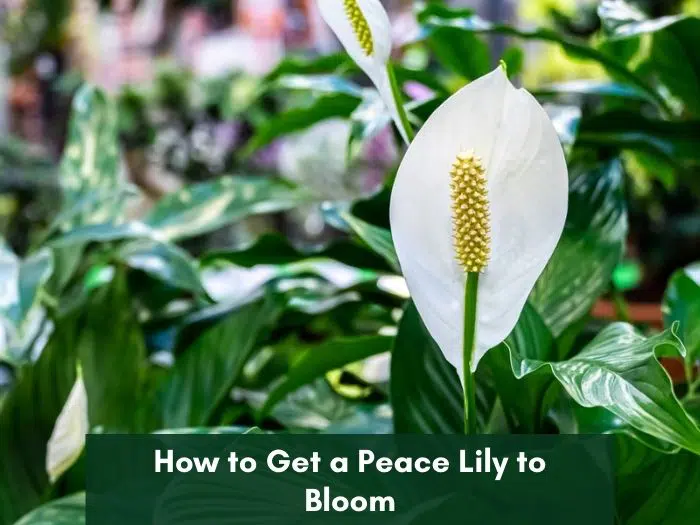
While peace lilies, like many flowers, are expected to bloom in the spring and early summer, sometimes they’re erratic at it and may not bloom at all, or bloom way later than usual.
Here are the reasons why peace lilies may not bloom:
Old plants
The most common reason for not flowering in peace lily plants is if they are old. When very old, the plant will fail to bloom or flower after a long time. The plant may also be characterized by other symptoms such as leaf yellowing that occurs too soon after the leaf emerges.
This leaves the plant with poor nutrition that impairs its optimum growth that usually leads to failure to bloom.
If your peace lily is not flowering, you might want to check its age to rule out this reason. Young peace lilies are expected to bloom at least once a year if they’re provided with optimal conditions for growth and development.
Insufficient light
Another reason for peace lilies, not flowering is insufficient light. Too much light can stress out peace lilies while too little light is not enough for adequate photosynthesis. Both environmental light problems can affect a peace lily plant and make it fail to bloom.
Peace lilies prefer indirect bright sunlight, so if you’ve not placed your plant near a window that receives enough sunlight, that could be the reason why it is not blooming.
Inadequate watering
A peace lily won’t flower if it is not growing in moist soil. Enough water, together with gentle light and warmth, provides the ideal conditions for a peace lily to flower when the right time comes.
Inadequate water means nutrients cannot be translocated throughout the plant, leaving the plant poorly fed and conditioned. Sometimes, lack of water can cause peace lilies to wilt and droop easily.
RELATED: HOW TO REVIVE DROOPING PEACE LILY
Poor soil nutrition
Lack of fertilizer can mean your peace lily is not getting adequate nutrients for cell division which leads to plant growth and development. Flowering is part of a plant’s growth, which means without soil nutrients, the plant may fail to bloom.
Soil pH issues could also be the reason why the plants are not growing and producing flowers as expected. So, test the soil with a soil pH test kit to make sure the pH is within the preferred range of 5.8 to 6.5. If not, the best solution is to correct it with the right potting mix that hasn’t gone bad.
Temperature problems
Another major environmental factor that may stop peace lilies from flowering is temperature. When it is too cold, e.g. during winter, most plants do not produce flowers as the buds die off. Peace lilies are not an exception.
Peace lilies like to grow in warm conditions (between 68 and 85 °F ) the failure to bloom maybe because of temperatures that are too low or too high. Very hot conditions mean the plant is losing too much water too fast, leaving it with very little for growth and development. That’s why it may not bloom.
Young peace lily
Sometimes, failure to bloom after you buy the plant could be caused by the peace lily being too young to produce flowers. If you bought your plant with a spathe or white flower, chances are that it was forced to bloom.
Commercial growers of indoor and outdoor plants use gibberellic acid, a potent hormone that controls the growth and development of plants. The effects of this hormone include increased stem, leaf, and root growth. Young peace lilies can be forced to bloom with gibberellic acid.
How to get a peace lily bloom
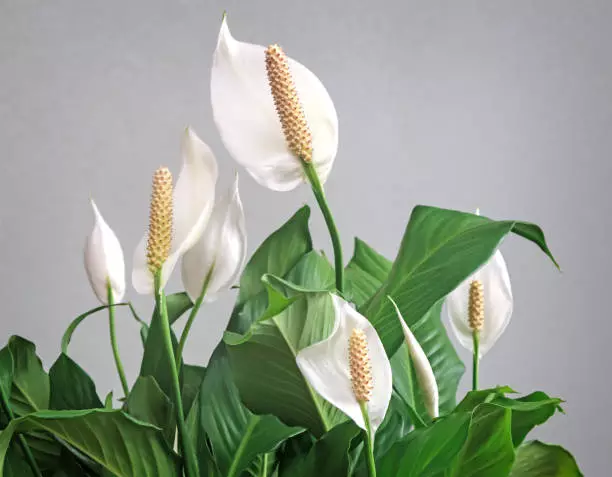
Proper plant care is enough to make a peace lily produce flowers every year. Cultural care and maintenance practices such as timely pruning of peace lilies, correct watering, lighting, and temperature control can help the plant bloom easily.
RELATED: WHEN IS THE PERFECT TIME TO PRUNE YOUR PEACE LILY
Here’s how to get a peace lily to bloom regularly:
1. Provide optimum light
To help your peace lily bloom, provide bright indirect light by placing it near a window that receives enough light. Ensure that the light is filtered as opposed to direct rays. A window with a curtain that lets light in is a great spot to place your peace lily and make it bloom.
However, if the flower is not blooming yet it is in a well-lit spot in the house, you might want to check and make sure insufficient light is the actual reason for the problem.
- Check if you’ve kept your peace lily in a dark room
- Check if the plant receives too much direct sunlight
Try to mimic the plant’s preferred natural lighting when it grows in the wild. In fact, when growing in the wild (Spathiphyllum are native to the tropical rainforests of the Americas), peace lilies, thrive well under indirect sunlight, where they bloom even twice a year.
2. Keep the soil moist
A great way to ensure that your peace lily blooms are to ensure that it gets enough water to support healthy growth and development.
Here are tips to water your peace lily and help the plant flower:
- Water the plant once a week, but wait for the top 1-2 inches of the soil in the pot to dry out before watering again.
- Keep the soil in the pot moist, especially in the root zone.
- Ensure the container has a drainage hole to prevent overwatering your peace lily.
RELATED: HOW TO REVIVE OVERWATERED PEACE LILY
If you’re not able to keep up with the watering schedule of the peace lily yet you want to help the plant flower, try using watering globes that can keep the soil moist for about 14 days.
This way, you’ll make sure the Spathiphyllum’s water requirements are met all the time and that it can grow and bloom again.
3. Apply fertilizer
A peace lily that’s not flowering due to lack of food (fertilizer) might show other symptoms such as stunted growth, curling leaves, and failure to produce flowers. The good news is that you can fix this by feeding the plant with the right fertilizer to help it thrive and bloom soon enough.
- Apply a water-soluble fertilizer for houseplants.
- Water the plant adequately after applying fertilizer.
A good fertilizer to use for your indoor plants is Miracle-Gro Liquafeed All-purpose plant Food. Be careful not to feed the plant excessively especially if you’re using a granular fertilizer, as it can easily cause root rot, other fungal infections, and fertilizer burn.
4. Provide warmth
Peace lilies like to grow in warm conditions where temperatures range between 68 and 85 °F. The plant can tolerate and thrive in nighttime temperatures of about 10 degrees.
Try to regulate the temperature in your house to a range between 68 and 85 °F, which is optimum for peace lilies to thrive and bloom.
- Keep your peace lily away from heated vents and radiators.
- Peace lilies don’t like cold, so keep them away from cold drafts such as air conditioning vents.
5. Try gibberellic acid
If you’ve tried all the natural ways to make a peace lily flower but to no avail, hormonal therapy might be your best option to make the plant bloom.
Buy a gibberellic acid product and feed the peace lily with it in the form of a spray on the leaves or rooting culture in the rooting zone. This will speed up the flowering process, especially if the plant is old. It is also a great way to force peace lilies to bloom faster if they are young.
How often does peace lily bloom?
When well taken care of, peace lilies can bloom up to two times a year. The white flowers appear in the spring and also in the fall. However, in some cases, peace lilies may bloom just once a year and that is normal.
If the conditions are not right, some Spathiphyllum plants may not bloom at all. To help them bloom, provide optimum growing conditions such as adequate moisture, nutrients, light, and warmth.
In addition, prune the stalks after the blooms fade and wilt to maximize nutrient efficiency that can help the plant bloom multiple times every year.
How to make a peace lily flower again
Peace lilies with a white flower are very attractive – a reason why most homeowners would want to ensure the plant produces flowers at close intervals. If the plant has already flowered in the spring, you might have to wait until the next season for it to produce flowers. But, can you make a peace lily flower again?
The best way to make a peace lily flower again is to prune and remove the spent flower and its stalk as soon as you see signs of wilting or browning to allow new blooms to emerge.
You shouldn’t expect the blooms to appear soon after the previous ones wilt, as it might take a few months from spring for the peace lily to bloom again. To increase the chances of making the plant produce flowers again, provide bright indirect light, enough warmth, and moisture.
Can a peace lily bloom all year?
Peace lilies can bloom all year if they’re force-bloomed using gibberellic acid, which works by speeding up cell division and cell elongation, leading to faster growth rates. With this method, plants can usually be force-bloomed all year round, even in winter.
The use of gibberellic acid is – however mostly confined to commercial growers, as the acid is hardly ever available in retail stores.
Even if you were to somehow get your hands on some, you should take extreme caution, as spraying gibberellic acid on your houseplants to spur foliage growth and flowering is the trigger production of misshapen flowers if overdone. So, you’ll want to be extremely careful.
Resources:
[1] Rachel Weinstein, Science Buzz: Maximizing Gibberellic Acid’s Efficiency to Increase Growth
[2] Leonard P. Perry, Extension Associate Professor, University of Vermont: Why Plants Fail to Bloom
